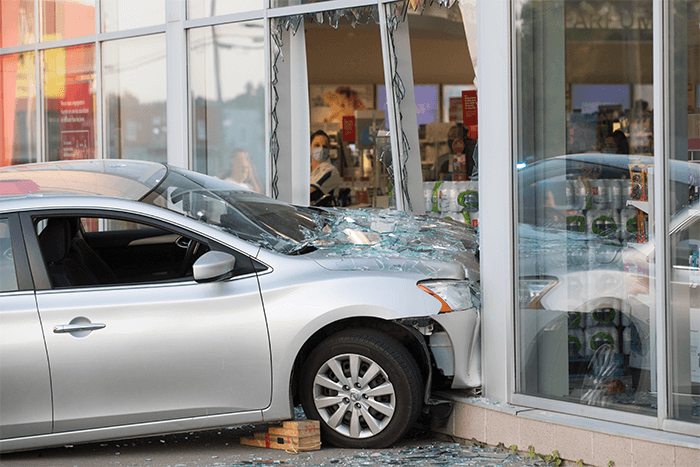In general, buildings are constructed to withstand a variety of forces; wind and snow loads, the weight of the building itself, and the weight from its intended use, such as occupants or equipment, all need to be accounted for when a structure is designed. However, occasionally, something else might impart forces on a structure that wasn’t specifically considered during the design process: a vehicle. This might be in the form of a low-speed sideswipe when someone enters their garage at the wrong angle, a tractor-trailer unit that impacts a loading dock when making a delivery, or an out-of-control vehicle that careens off the road and into a house. Whatever the case, the steps to repair a building are similar.

First, and most important, is ensuring the structure is stable and safe to enter. Typically, an engineer will be called in to review the damages, and if necessary, recommend temporary shoring to ensure the stability of the building. Sometimes, a portion of the building is being supported by the vehicle that impacted it, and there are concerns about removing the vehicle, while ensuring the security of the structure. An engineer can provide suggestions on the necessary precautions or issues that arise when completing the removal and propose solutions to remove the vehicle while limiting additional damages to the building. Alternatively, if a portion of the structure is so damaged that it cannot be made safe or it is not economically feasible to repair, an engineer may recommend demolishing it. Once the safety has been ensured, the investigation can proceed.
To determine the extent of the damage done by an impact, the finishes may need to be removed to reveal the support structures near the impact location. Any displacement of wood studs, columns or posts, concrete or masonry, cracks, gaps, or other signs of movement, must be carefully examined and analyzed to determine where the forces imparted on the structure travelled and how that affected the integrity of the structure. The forces from an impact are dependent on the mass of the vehicle, its velocity, and the distance required for the car to come to a stop. A good portion of the energy from the moving vehicle is dissipated through the vehicle itself during the impact but still, these impacts can result in considerable forces being imparted on the structure. Photos are taken and sketches of the building are done to document the scene and provide a detailed account of the damages. From there, repair instructions with details about replacement members, connection details, and finishes are provided, which ensures the structure is rebuilt to its original standard.
Not so simple
This might seem straightforward, but it seldom is. The age of the building, different types of construction and materials, and a host of other issues all play a part in reconstruction after an impact. Aged concrete can crumble while being repaired, necessitating delicate and extensive replacement and damaged foundations can require temporary support of the structure above during the repairs. For older rubble foundations, a compatible mortar is required to suit the existing mortar that will remain in place. Consideration must also be given not to create new moisture problems that may have not existed previously, by altering the performance characteristics of the foundation or the building envelope. Every structure has nuances that must be considered to ensure the structure is repaired appropriately, and that all the idiosyncrasies present are managed and resolved.
Additionally, sometimes damage that appears extensive might require minimal repairs or things that appear minimal can be significant. If the affected wall isn’t load bearing, reconstruction might be less difficult. Alternatively, important damage to a structure may be hidden behind the building’s finishes not within the immediate impact zone. The connections between structural members affected by the impact should be checked for any movement, as this is a common location for movement between members to occur.
An engineer is also helpful in determining what damage is related to the impact, and what was pre-existing. Often when a vehicle impacts a structure, the property owner may become more aware of damages within the building and begin to notice cracks or other damages throughout the building that they hadn’t noticed before. An engineer can often differentiate between new and pre-existing damages. This is commonly done by assessing the appearance of cracks or newly formed gaps. Colour differences and the brightness of material within these openings, the sharpness of crack edges, and debris within the openings are some of the characteristics used to determine if the damage is new or pre-existing.
Whatever the circumstances, the structural team at CEP is here to help determine the best way to repair the damaged building.
